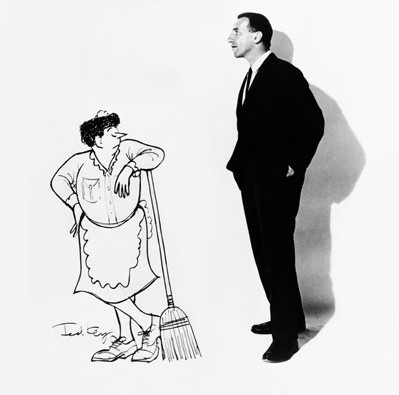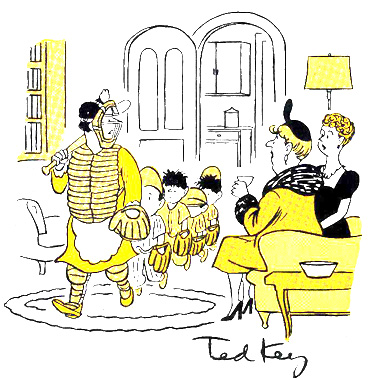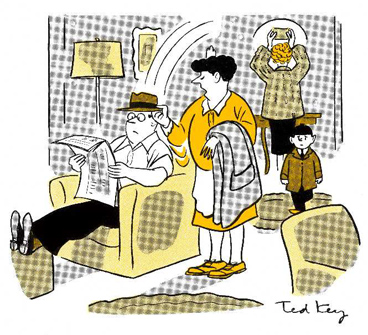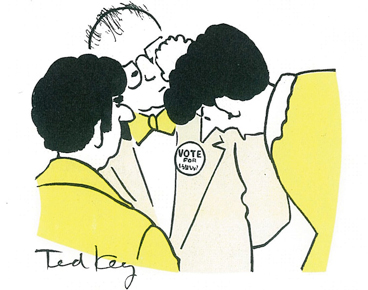The Man Behind Hazel

Hazel with her famous creator Ted Key.
Images courtesy Peter Key
© The Estate of Ted Key. Used with Permission.
Ted Key was born Theodore Keyser in 1912. By the middle of the 20th century, his Hazel cartoons were arguably the most popular single feature in The Saturday Evening Post, better known even than Norman Rockwell’s famous illustrations.
In 1961, Hazel was transformed into a TV show that ran for five seasons with Shirley Booth in the lead role.
Not just a cartoonist, Ted Key wrote the stories for three Disney movies and the script for one, The Cat from Outer Space; he wrote four children’s books, one of which was made into the movie Digby, the Biggest Dog in the World; and he created a long-running series of inspirational posters for corporate clients.
Along the way, Key invented a raft of lovable characters, from Diz and Liz–featured in a long-running cartoon in Jack and Jill magazine, a sister publication to the Post–to Johnny Daydream and his pet Beware the Dog. If you haven’t heard of the latter, it’s because by the time they aired on television in 1959 as part of Rocky and His Friends they had become Mr. Peabody (the time-traveling dog scientist) and Sherman (his adopted boy). The pair soon gained their own cult following and hit the big screen earlier this spring in DreamWorks Animation’s Mr. Peabody & Sherman.
Ted Key passed away in 2008, but his wit and his characters occupy a permanent place in our collective memory. Late last winter, The Saturday Evening Post met with Peter Key, the youngest of Ted’s three sons, to ask about life with his famous dad.
The Saturday Evening Post: As your dad once wrote, he wasn’t really proud of Hazel as she first appeared, but she morphed into something wonderful. Can you recall her evolution?
Peter Key: Well, this happened before I was born. But he always said the idea came to him in a dream. At first, Hazel was skinny and not too bright, the kind of maid that got everything wrong. The cartoons worked; they sold right away. But he didn’t like her being stupid. Gradually she got smarter and more full-figured. And in the process, Hazel became a much more interesting and endearing creature.
SEP: What does this say about your dad?
PK: He truly was a very nice guy. He seemed to get along with everyone. He would chat up bank tellers, people at the post office, the mailman.
SEP: No dark side at all?
PK: I remember him getting angry at stupid stuff we kids would do. But, no, he really didn’t have a dark side.
SEP: Where did the name Hazel come from?
PK: My dad maintained that the name Hazel came “out of the blue.” But, funny story, he later found out that Bob Fuoss, then the managing editor of the Post, was given the silent treatment by his sister for three years when the cartoon first started running. Her name was Hazel, and she thought Fuoss had selected the name to ridicule her.
SEP: Your father worked for the Post for many years. Did he ever meet Norman Rockwell?
PK: For a few years, he submitted ideas to the Post for Rockwell covers.
SEP: Were his ideas used?
PK: Well, yes, but Rockwell didn’t like having cover ideas dictated to him. So, it was a bit of a dance. My father would sell cover concepts to Ken Stuart, the art editor at the time. Then Stuart would call Rockwell and ask him what he was working on. Rockwell would tend to say he had several projects going, but if he wasn’t specific, Stuart would run my dad’s ideas by him, and typically Rockwell would reject them all. Then a few weeks later Stuart would call Rockwell and again ask what he was working on. Rockwell would say, “Oh I have this great idea!” and it would be one of my dad’s concepts. In fairness, Rockwell always made these ideas his own.
Purchase the digital edition for your iPad, Nook, or Android tablet:

To purchase a subscription to the print edition of The Saturday Evening Post: 
Cartoons: Everybody’s Favorite Maid
For more than 25 years, Ted Key’s cartoon character Hazel graced the pages of The Saturday Evening Post as the Baxter family’s maid. But readers knew who really ruled the roost.
First published in 1943, the single-paneled cartoon series quickly became a hit. Later on, it even inspired a TV show by the same name that ran for five years in the 1960s.
Cartoons © The Estate of Ted Key. Used by permission.

“Then I add my mayonnaise …”

“Spring Training.”

“You’re Eating Out.”

“You’ve got to be kidding!”

“Don’t sh-h me! I said it once and I’ll say it again!
Woman’s place is in the home.”

“How big was this frog?”

“I’ve had a LONG, HARD day.”